Pilots N Paws – Heroes in the sky – The whole story
Original article by S. Veigel November 29, 2020
Photos provided by Pilots N Paws – Debi and Brock on tarmac photo by Scott Holloway
More Satisfying than a $100 Hamburger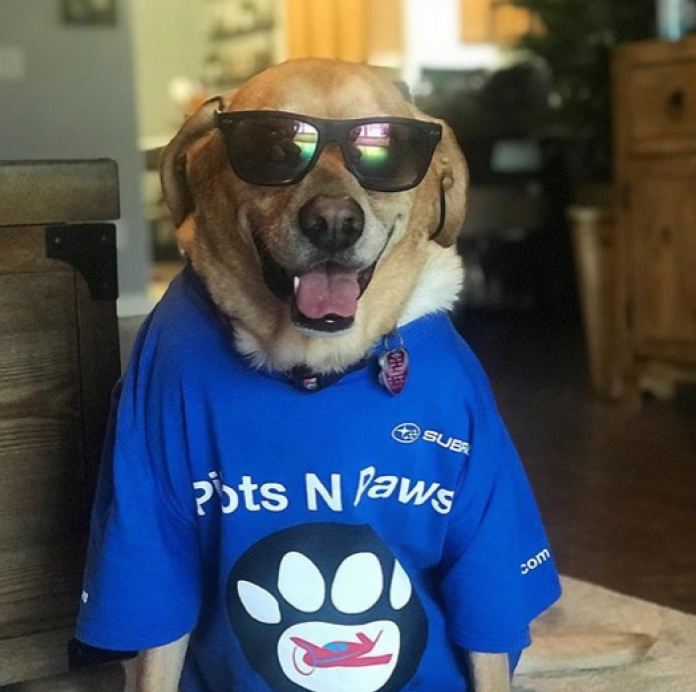
Whether you’re a pilot looking for a great reason to take your plane up, an established rescue, an individual trying to get an animal into a home, or even if you’re just looking for a good story, let me tell you a great one. Let me tell you how the owner of a metal fabrication business in New York, a Nurse in Akron, Ohio, a 15 year old kid and a dog named Brock all came together to start a national volunteer organization we can all get on board with.
I: Years and Miles Apart – Who knew?
Brock – Tallahassee, Florida
In 2007 a Doberman named Brock was forgotten in a kennel in Tallahassee, Florida. His ribs were showing and his face was scarred. He had been rescued from a dog fighting ring where he had his k-9 teeth filed down and was cut to draw blood. Brock was a “bait dog”. His fate was to be there so the other fighting dogs could learn to attack him. Now he was just living in an animal shelter with a high probability of being unwanted and euthanized.
Jon Wehrenberg – New York to Knoxville, Tennessee
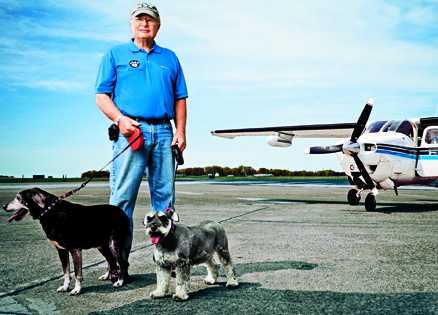 Jon Wehrenberg lived in Knoxville, Tennessee with his wife Diane. Jon sold his metal fabrication business in New York at age 64 but kept his Cessna P-210 that he owned for 25 years. He used to fly it on business trips. But now Jon was bored and looking for any reason to fly; as pilots do.
Jon Wehrenberg lived in Knoxville, Tennessee with his wife Diane. Jon sold his metal fabrication business in New York at age 64 but kept his Cessna P-210 that he owned for 25 years. He used to fly it on business trips. But now Jon was bored and looking for any reason to fly; as pilots do.
Jon and Diane were caring people, as Debi Boies (Co-Founder and President of Pilots N Paws) told me in 2020 “they were very informed about rescues. They supported their local humane society, they adopted; they did all that.” But Jon, who was now contemplating selling his plane, had no idea what would happen next.
Debi Boies – Akron, Ohio to Florida to Landrum, South Carolina
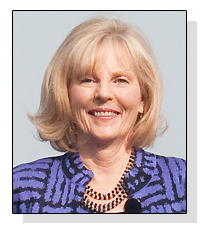 As a young lady Debi Boies attended nursing school in Akron, Ohio and later married a business man who retired early. Wanting to get away from all the snow in Ohio they moved to Florida expecting very nice weather. But it wasn’t quite to their liking. So Debi and her husband eventually settled on a farm in horse country around Landrum, South Carolina where she raised Morgan Horses.
As a young lady Debi Boies attended nursing school in Akron, Ohio and later married a business man who retired early. Wanting to get away from all the snow in Ohio they moved to Florida expecting very nice weather. But it wasn’t quite to their liking. So Debi and her husband eventually settled on a farm in horse country around Landrum, South Carolina where she raised Morgan Horses.
Now a retired nurse Debi put her talents to work for a rescue called “Special Needs Dobermans” where she was a “Case Manager”. There it was her responsibility to contact veterinarians in the area where dogs were located and negotiate with them to see if she could get better fees for the recue where the dogs were. Through this work she met other Dobi-minded people and started a Doberman Assistance Network. Because, Debi told me, “We saw where many Dobermans would be in shelters and they’d fall through the cracks.”
“You know”, Debi explained to me, “a rescue might call or someone might call and say, ‘Ok I’m going to come and pick you up on Tuesday’ and then nobody showed up on Tuesday. So, we filled that niche for a number of years.” So “I was a case coordinator for that where I had to go and contact the shelters and then I had to contact a hands-on rescue group, to foster, take care of and schedule transports. And it was a big thing to pull a Doberman out of a shelter. Everybody thinks you just go get them. No. You have to find a reputable person who can get them intermediate care, take them to the vet and then a long term rescue that’ll consider taking them in”.
Debi worked with the Doberman Assistance Network “up through 2007”. Sadly, Doberman Assistance Network, Debi told me, just disbanded in 2019 but “now they provide a service with raising funds for medical Dobermans, it’s just a different name now.”
“People get burned out in rescue. I couldn’t even sleep at night.” Debi told me. “I was like, ok, what am I going to do. I have to get up in the morning and I have to find this Doberman some place to go. Because it’s only got 3 days and they’re going to euthanize him. And the stress was just unbelievable.”
Debi. Meet Brock.
II: Mounting a Rescue
“I think it was the fall of 2007”, Debi Boies told me during a phone interview. She learned of the Doberman named Brock being held in a Florida animal shelter and she wanted to get him out before he was euthanized. The plan was to go to Florida and bring him back to Landrum to live with her. She wasn’t concerned about the 7 hour drive to get there but there was some concern about a 7 hour return trip with a sizeable dog riding in the back of their car. There wouldn’t be much room and Brock had already gone through quite enough already.
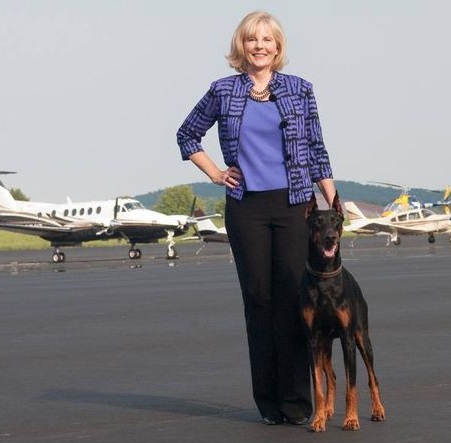 Jon Wehrenberg recounted the rescue attempt in a 2011 Guideposts article written by him. According to Jon he was about to give up his plane when he got a call from Debi Boies. ‘” Hey, Jon, I’ve got a strange favor to ask,” she said. “I remember you saying that pilots jump at any excuse to fly.” I chuckled (Jon recounted) “That we do. What’s up?”’ And, long story short, the journey began. Debi was afraid of flying so her husband flew with Jon to Florida, picked up Brock and 90 minutes later they landed at Landrum airport where Debi was waiting. Jon again recounts, “As soon as I finished filing paperwork for our flight, I joined them. Debi was stroking Brock’s back and he was leaning into her hand, as if he knew she’d give him the loving home he deserved.”
Jon Wehrenberg recounted the rescue attempt in a 2011 Guideposts article written by him. According to Jon he was about to give up his plane when he got a call from Debi Boies. ‘” Hey, Jon, I’ve got a strange favor to ask,” she said. “I remember you saying that pilots jump at any excuse to fly.” I chuckled (Jon recounted) “That we do. What’s up?”’ And, long story short, the journey began. Debi was afraid of flying so her husband flew with Jon to Florida, picked up Brock and 90 minutes later they landed at Landrum airport where Debi was waiting. Jon again recounts, “As soon as I finished filing paperwork for our flight, I joined them. Debi was stroking Brock’s back and he was leaning into her hand, as if he knew she’d give him the loving home he deserved.”
Sometime after their return, Debi told me, she was sitting in her office chair and Jon was standing in the door. Searching for some sort of sense about it all Jon asked, “Debi, why are you moving these dogs?” Recounting that some of her trips to transport an animal were “16 legs and 2 days long” Debi responded, “Because we just need to get them some place safe. We love the animals and, that’s why we do it.”
Jon answered Debi’s concerns with a suggestion, “Well, Pilots are always looking for a good reason to fly.” To that Debi responded, “Well let’s put them together and why don’t we call it Pilots N Paws.” Jon looked at Debi and said, “Great.’
“I said Ok, let’s go”, Debi continued. “And we had no idea what we were doing really. I mean Jon’s 15 year old grandson actually started a website for us and that’s after we piggy backed on another pilot that we knew. He had an online forum board so we used that to begin with. And it was just one step in front of the other. One step in front of the other. It was easy to reach the rescues, it was more difficult to reach the pilots. We just started attending aviation events. Jon knew the aviation side, I knew the rescue side and we just worked together until we got it right.”
Recalling an interview she had with AOPA (Aircraft Owners and Pilots Association) Debi chuckled and said, “I’ll never forget it because the person who authored the article, I heard later on and he actually shared it with me too, said, ‘You know I didn’t think this would ever fly; literally’. And I said, well, you never know until you try”
III: Pilots N Paws Takes Off ; Literally
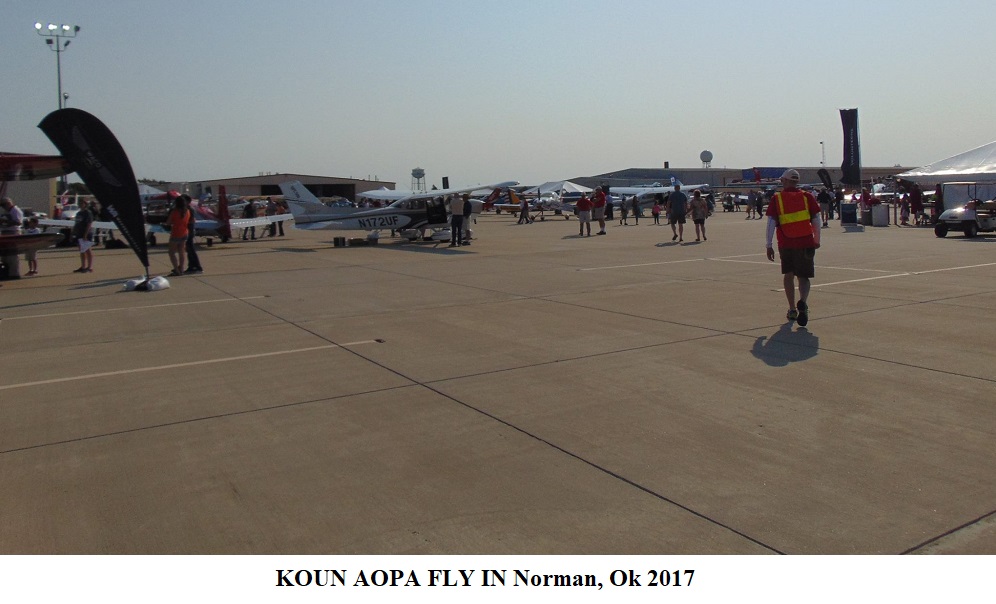
Pilots N Paws officially went on line in February of 2008. By 2010 the group would organize events they called “Flyways” where pilots would come into a small designated airport the day before and animal rescues would bring in animals they needed transport for. Debi and her team would be in charge of organizing who would take which animal(s) where and map out connecting links with other pilots in distant locations.
The very first big Flyway for Pilots N Paws was during the Gulf oil Spill in 2010 where pilots N Paws organized 3 legs of pilots and transported 171 animals across the eastern United States. Among the animals transported throughout their history the most memorable, according to Debi, might be a burned bear from the California wild fires and having to build a pool in the back of a plane to transport a baby dolphin. But the most memorable Debi said will always be etched in her mind, was a man dying of cancer.
“There was a man dying of cancer”, Debi recalled, “and he actually lived in Florida but his treatment protocols, I think, were in Pennsylvania, if I remember correctly. And he thought he was cancer free but then it came back and he ended up there for treatments and the prognosis was not good”
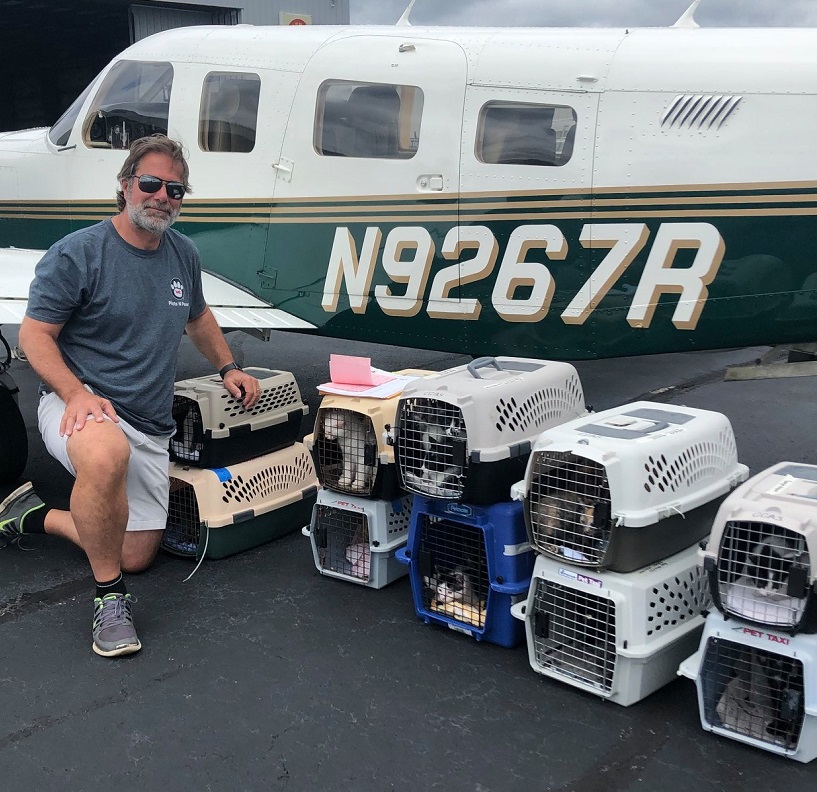
“The only thing that man wanted to do”, Debi continued, “was to see his dog again before he passed. And the dog was also a service animal for his wife who was diabetic. So our pilots worked together and made that long chain of flights from Florida, up to Pennsylvania and I think he was able to have his dog lay on the bed with him 2 days before he passed.”
Flyways were complicated and fun events. A convention of rescues, animals, planes pilots and maybe a local Mayor giving a speech. But this also became too much of a challenge because everyone wanted to participate. “The airports can only hold so many planes”, Debi explained to me. “The last Flyway there was a pool of 75-76 planes involved at different locations and you’ve got like 400 animals.” So, though Pilots N Paws is still going strong, Flyway events had to take a pause for now.
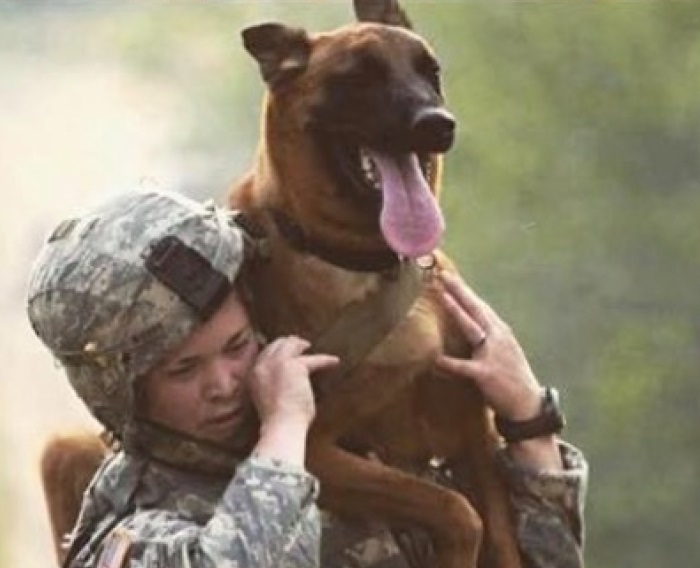
In the 12 years (2008 thru 2020) that Pilots N Paws has been operating as a VPO (Volunteer Pilot Organization) PNP has grown to nearly 6,000 volunteer Pilots across the United States with 12,000 non-pilot volunteers. These people come together to provide flights for more than 15,000 animals per year. Including to help reunite military dogs with military personnel and dogs military personnel adopted overseas. Together PNP members have helped to save 175,000 animals since PNP was founded. And they have responded to everything from floods in the Carolinas, to hurricanes, to fires in the west and more.
IV: Enter Sue Haas – A Pilot’s View
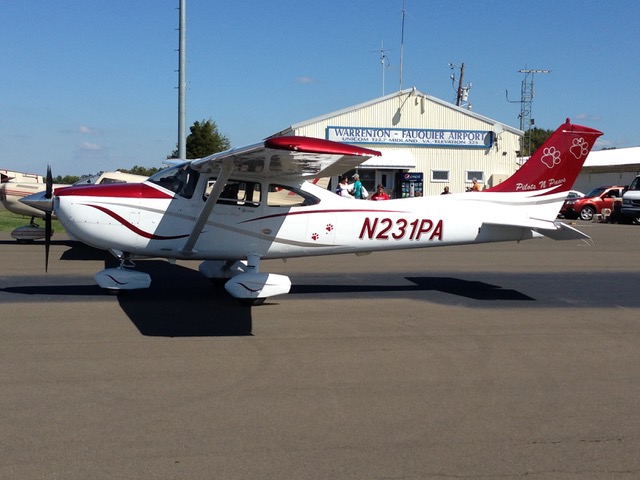
As I was researching this story I wanted to get a pilots perspective. After all it is “Pilots” N Paws (PNP). Kate Quinn, the Executive Director for PNP, suggested I speak with Sue Haas. A very busy lady, I might add, who worked with PNP “pretty much since we started”, Kate told me. It took a while but it was worth it. I spoke with Sue on the phone November 4, 2020.
Sue Haas is an airline pilot with 30 years of experience who lives in Virginia. As an airline Captain she flies Boeing 757 and 767 aircraft. In her personal life Captain Haas owns a 2000 millennial edition Cessna 182 with a Pilots N Paws tail design. Sue is also a foster failure. That means you intend to foster an animal and end up adopting it. Sue’s new family member is a rescued Staffordshire terrier mix she calls Hanna Banana.
When Sue volunteers to transport an animal(s) for Pilots N Paws by herself the animals ride in a crate or kennel (like all pilots do) so she can safely focus on the plane. But there are times when she’s transporting a dog in the back seat restrained by a harness. When she does that she always flies with a second pilot in case one of them needs to tend to the passenger. The second pilot flying with Sue is often her friend John Fontaine. Captain Fontaine’s “day job” is piloting Boeing 787 aircraft.
The first thing I wanted to ask Sue was, “How did you get started with PNP?” “It was a web search; online”, Sue explained. “I had decided that I had the time and I thought, you know, I’ve heard of different kinds of transports and people moving rescue animals on the ground, I wondered if there was anything, anybody doing that in the air. So I just did a Google search and that’s when I found Pilots N Paws. I think Pilots N Paws had only been around for a few months when I found them online”.
Sue is primarily a pilot with Pilots N Paws but she has helped with some of the coordination, worked on some protocols for disaster relief and participated in the annual Flyways. Sue and Debi Boies became friends not long after Sue joined PNP.
The answer to my next obvious question was more detail rich. Basically, how does all of this work? To which Sue explained, “Most of the flights that we do are not coordinated by people other than the rescue and the pilots involved themselves; through the Ride Board (a feature of the “Transport” section of the PNP Bulletin Board). But every once in a while you’ll get a group of pilots together that say hey, let’s move a bunch of dogs the same day and they’ll have sort of a .. It’s sort of an event. It’s for Pilots N Paws but it’s not the same as it used to be”. Referring to the Flyway events.
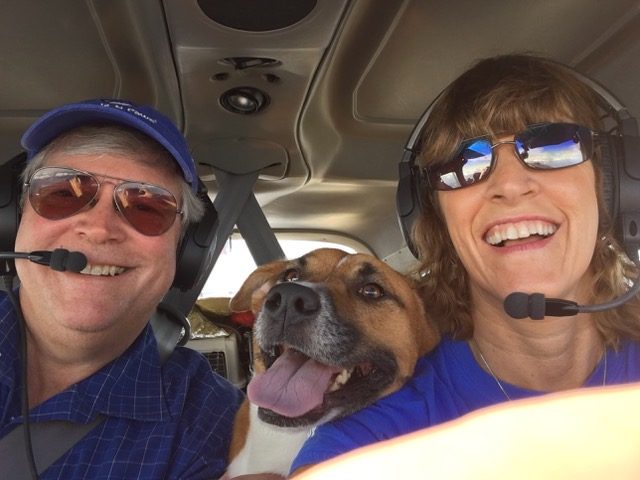
“So how is it working with the website?” I inquired. “Oh I think it’s extremely easy.” Sue responded. “I think it’s very user friendly. It pretty much answers any questions that you have if you’re a rescuer it also answers questions if you are a pilot. It’s easy to post it’s easy to reply. I think it’s very user friendly. I think it’s pretty easy for the rescues to get on there too and figure out. It’s basically a step-by-step process. They guide you through it. And then from the Pilot’s perspective it’s easy. You can set it up so that if a trip comes within so many miles, like I tend to think if it’s a hundred miles to me, I’ll get an email notice. The nice thing is there’s no schedule. If you want to do the trip you do the trip, if you don’t want to do it you don’t have to reply. Somebody else will probably pick it up. And so it’s very friendly as far as your schedule goes and people are very good, in my experience, with dealing with other pilot’s ‘weather minimums’”.
Sue continued to explain weather minimums and how PNP works with pilots. “Like for example some guys and gals can only fly outside of clouds, you know VFR, Visual Flight Rules. Some pilots aren’t comfortable if the wind is gusting to 20 knots. And I’ve never had anybody say, ‘Oh, I think you should go’ or put pressure on another pilot and I’ve never had a rescue do that either. So, that’s the one thing I appreciate about this group. There’s a lot of respect. There’s respect for boundaries, there’s respect for safety. And, I don’t want to use the word casual because that gives you the wrong impression, but as far as the scheduling goes.. It is because some organizations will actually sign you up for a flight a month ahead of time and you don’t know what the weather’s going to be and you don’t know what the winds are going to be, what the clouds are going to be like, what the storms are going to be like. So, it’s more flexibility, is a good way to put it.”
Following up on the PNP web resources Sue explained, “There’s also resources on the website for pilots to see what they need for transport. All the animals have health certificates. That’s one of the things that we require”.
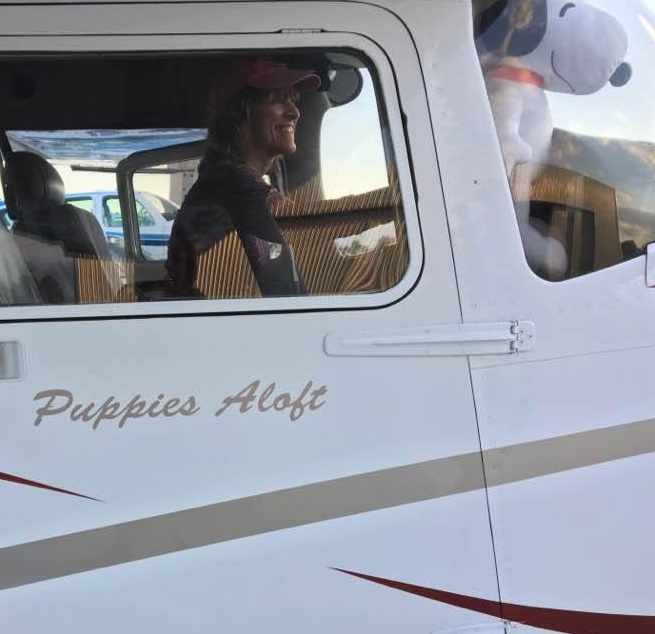
To my question about cost re-imbursement Sue explained, “Well you can’t help with any cost. But what they can help with would be supplies, such as crates, like for example ‘I need’, maybe, ‘I’ve never done this before or maybe my crate is old or maybe I’ve got to transport a dog that’s not the usual size that I normally transport’, so I can actually request, from Pilots N Paws, a crate. So they have a relationship with, I think it’s Petmate, and they’ll provide things like leashes and crates and things like that”. But they can’t cover expenses. That would actually be illegal.” Because it’s a 501(c)(3)? I inquired. “Well also that the FAA, as far as the Federal Aviation Administration, you’d have to have a commercial license and commercially maintain aircraft in order to take money for that. So the pilots can write their expenses that are directly involved with the charity flight, they can write those off on their taxes. But Pilots N Paws cannot reimburse them for anything.”
Finally, after a very helpful and actually fun conversation something Sue said stood out to me. She said, “From the pilot end of it, you know most pilots are looking for an excuse to go fly. You can’t do anything better than combining dogs and airplanes in my opinion. Or any animal. We can take any animals, not just dogs. But to be able to do something where you can do something good, like a rescue and combine it with something that you love, like flying, you can’t beat it.”
V: Where Has The Time Gone? – Epilogue
Jon Wehrenberg eventually retired from flying but he will forever be known as the first Pilots N Paws pilot who stepped up. Though my reference here may not be technically accurate, you could say Jon Wehrenberg flew the very first Flyway for Pilots N Paws. He will also be known for his generosity and good heart. Giving of his time, his plane, his support and advice to help Pilots N Paws literally get off the ground.
Brock found a new life with the Boies family. For a while he wouldn’t let anyone hug him. He seemed afraid they were going to grab him and do something. But “he was the kindest, most gentle, loving, sweetest, pleaser you could ever imagine” Debi recalls. “So I always say the greatest gift he gave to me, besides saving a lot of lives through Pilots N Paws, was that I was able to hug him all day long by the time he left us”.
Brock was with the Boies family approximately 6 wonderful years. He is estimated to have been about 12 years old when he finally passed.
Debi Boies eventually got over her fear of flying and, other than being President of Pilots N Paws, expanded her activities by also serving on the Board of Directors for Air Care Alliance.
You can keep current, join or donate to Pilots N Paws using the information and links below.
You’ll find a cool video promotion by Patty Wagstaff on the side bar of the home page there.
Pilots N Paws
4651 Howe Rd.
Landrum, S.C. 29356
Website: https://www.pilotsnpaws.org/
Facebook page: https://www.facebook.com/pilotsnpawsfanpage/